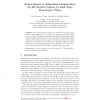Free Online Productivity Tools
i2Speak
i2Symbol
i2OCR
iTex2Img
iWeb2Print
iWeb2Shot
i2Type
iPdf2Split
iPdf2Merge
i2Bopomofo
i2Arabic
i2Style
i2Image
i2PDF
iLatex2Rtf
Sci2ools
MIRAGE
2009
Springer
2009
Springer
Region-Based vs. Edge-Based Registration for 3D Motion Capture by Real Time Monoscopic Vision
3D human motion capture by real-time monocular vision without using markers can be achieved by registering a 3D articulated model on a video. Registration consists in iteratively optimizing the match between primitives extracted from the model and the images with respect to the model position and joint angles. We extend a previous color-based registration algorithm with a more precise edge-based registration step. We present an experimental analysis of the residual error vs. the computation time and we discuss the balance between both approaches.
Color-based Registration Algorithm | Human Motion Capture | MIRAGE 2009 | Real-time Monocular Vision |
| Added | 26 Jul 2010 |
| Updated | 26 Jul 2010 |
| Type | Conference |
| Year | 2009 |
| Where | MIRAGE |
| Authors | David Antonio Gómez Jáuregui, Patrick Horain |
Comments (0)

